Snøhetta’s Campus Revamp of the Joslyn Art Museum Brings the Spirit of the Plains to the Heart of Omaha
Omaha

Architects & Firms
At the tail end of 1994, several months after Norman Foster was awarded that year’s AIA Gold Medal, the star British architect’s inaugural commission in the United States opened in a somewhat curious location: smack dab in the American heartland, in Omaha. An expansion project connecting to the Joslyn Art Museum’s landmark Memorial Building via a 200-foot-long glass atrium, the project marked a reserved stateside debut for the future Pritzker Prize laureate: a boxy, windowless gallery building wholly sympathetic to its older, Art Deco counterpart, completed in 1931. In a brief dispatch, Progressive Architecture asserted that Foster’s new wing at the Joslyn proved the skeptics—convinced that his firm “could not do a building that fits into a historic context”—wrong. From their height and massing to the matching cladding in the form of blush-colored Etowah (or Georgia pink) marble sourced from the same quarry, the two buildings are in such close dialogue that, for nearly three decades, it was difficult to imagine how an inevitable third building on the Joslyn campus would engage with its predecessors.
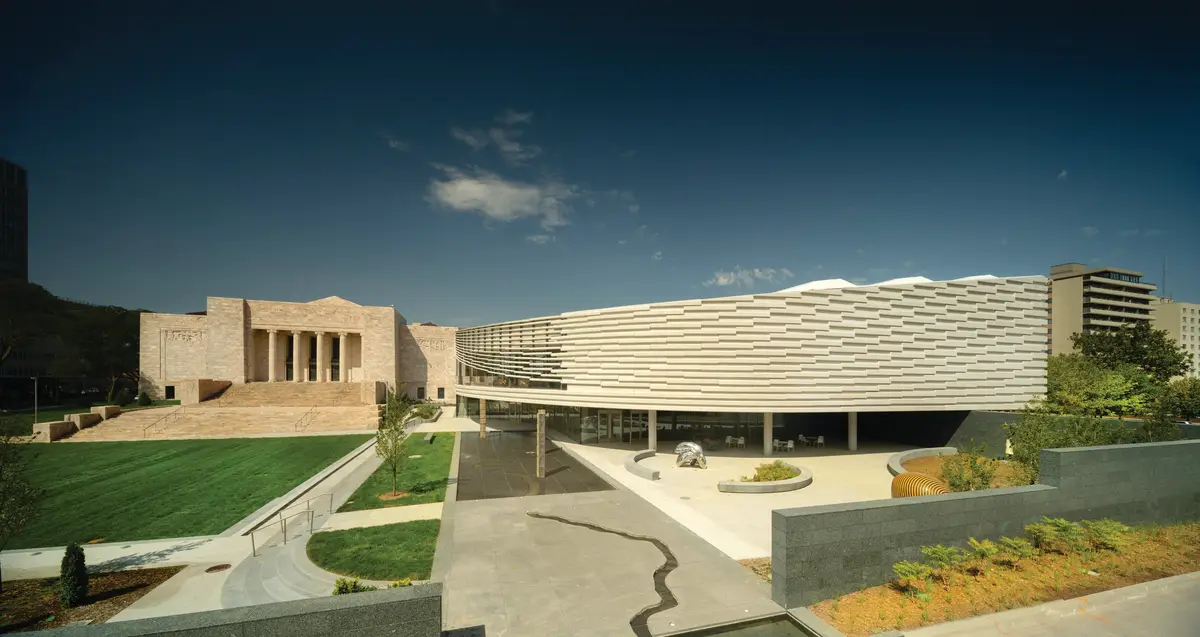
1
Canopies can be found on the south (1) and north (2) of the Hawks Pavilion. All three buildings are linked by an existing renovated atrium (3). Photos © Nic Lehoux, click to enlarge.
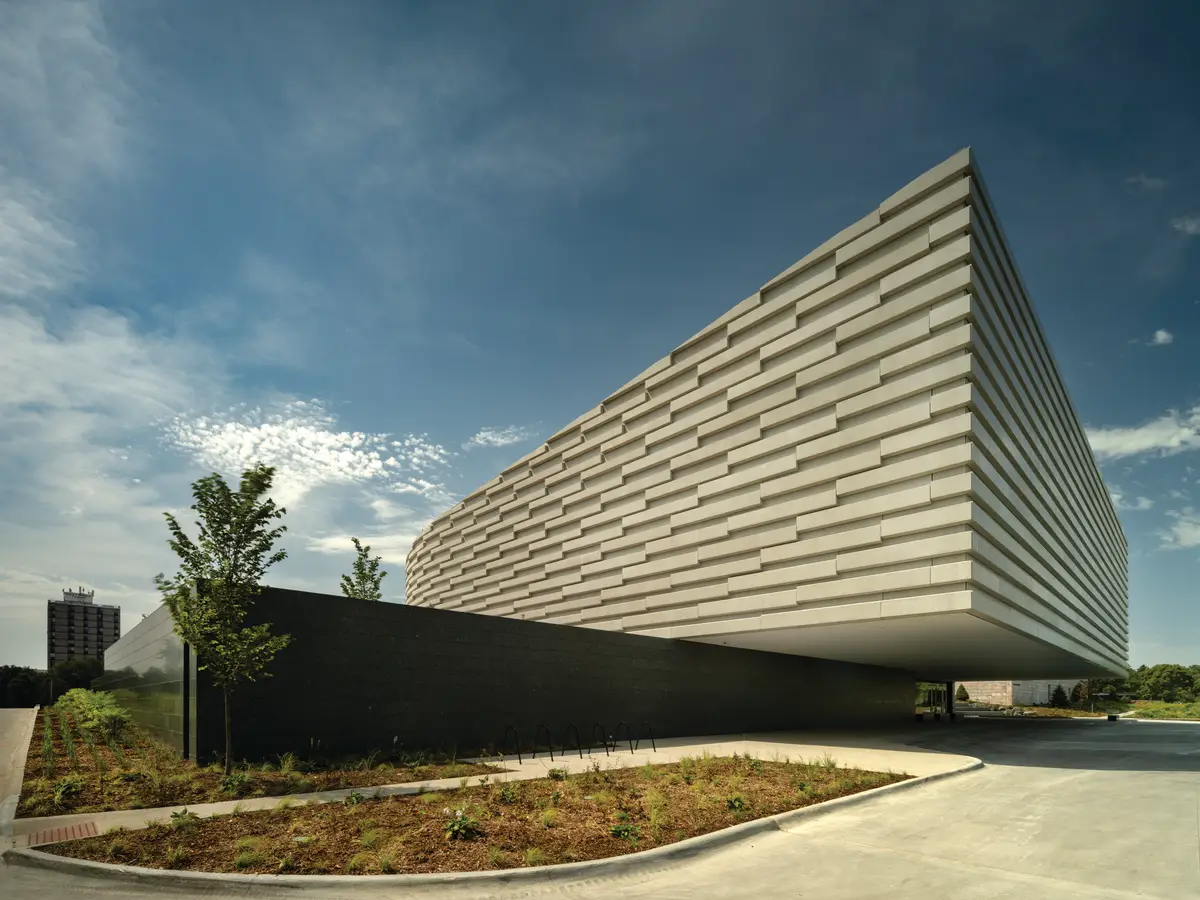
2
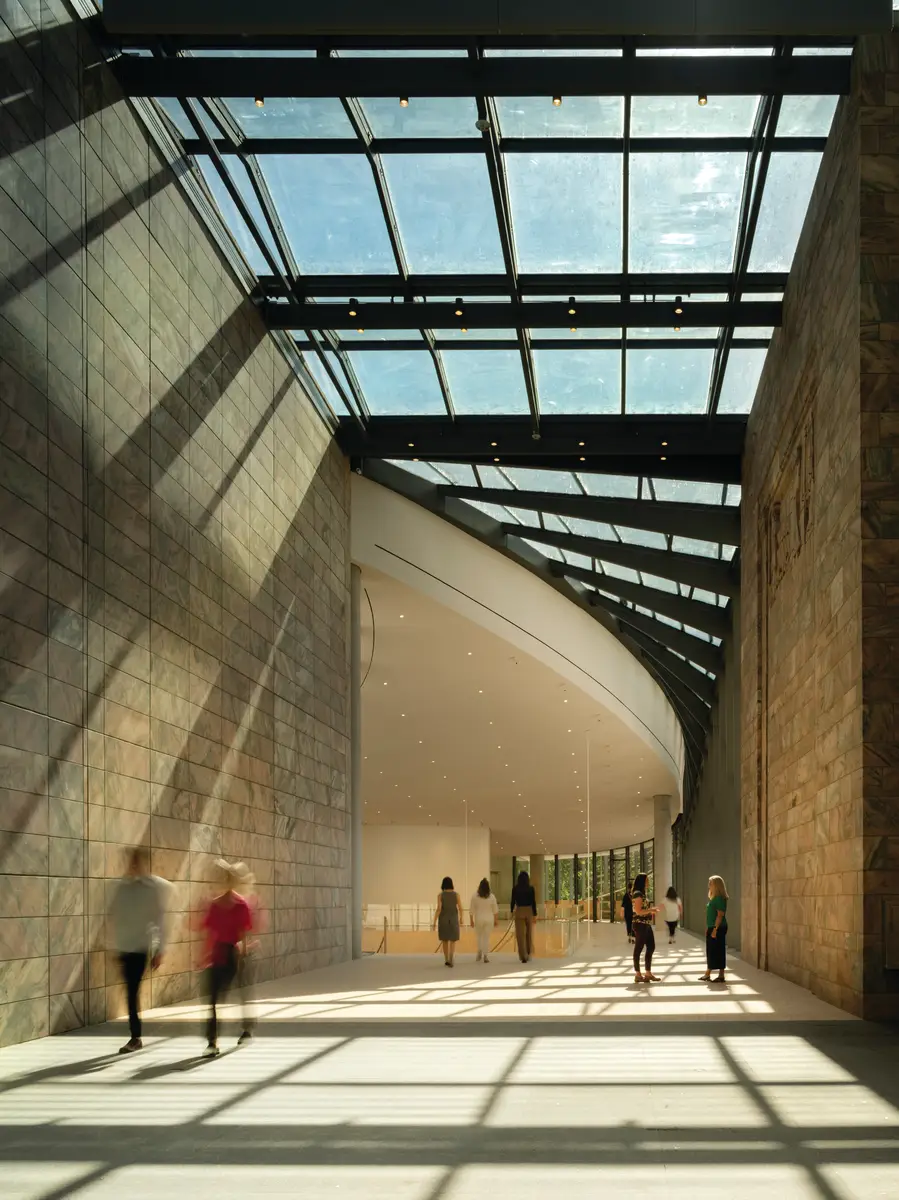
3
Now, the Joslyn is three with the September 10 opening of the 42,000-square-foot Rhonda and Howard Hawks Pavilion. Designed by Snøhetta, the steel-framed new structure comprises a museum store, community room, and soaring, column-free main-lobby atrium-cum-event-venue anchored by a wide, curving staircase that leads to 16,700 square feet of gallery space spread across the building’s second level. The Hawks Pavilion’s “twist” connector flows into the museum’s existing glass-topped passageway, fusing itself with Foster’s addition and the Memorial Building, which underwent a substantial renovation. Foster’s atrium got a fresh-up too, including replaced glass panels, much-needed hanging acoustic baffles, new lighting, and a revamped café and servery. All were part of a more than $100 million overhaul under the leadership of Jack Becker, who assumed the role of director and CEO of Nebraska’s largest art museum in 2010.
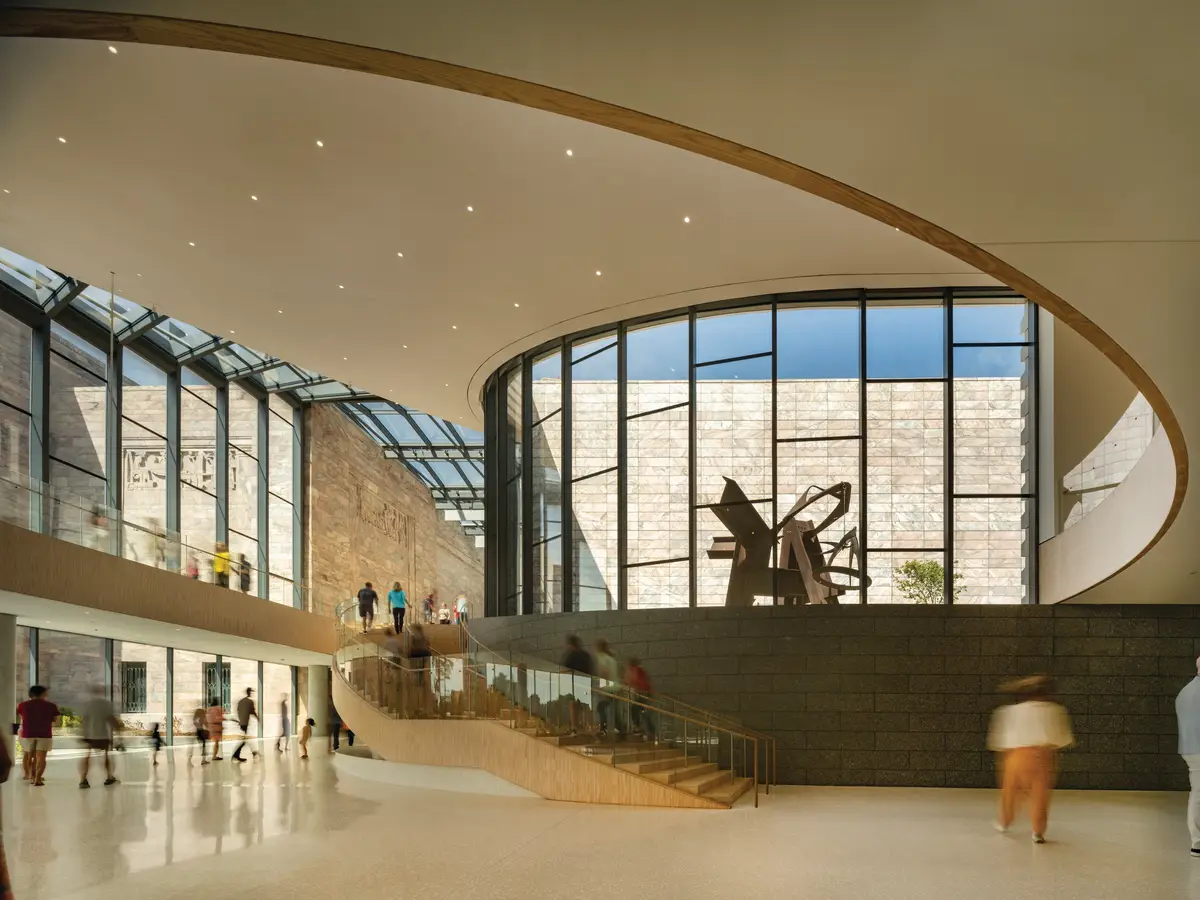
The Hawks Pavilion’s Phillip G. Schrager Atrium offers views of the Memorial Building, 1994 Scott Pavilion, and entry garden. Photo © Nic Lehoux
The New York office of Snøhetta was selected for the project alongside partnering local firm Alley Poyner Macchietto Architecture in 2018. With the Hawks Pavilion, Snøhetta eschews the path of deference taken by Foster, opting for subtle yet playful nods to the building’s predecessors, mainly in its facade. A similar approach was taken by the firm with respect to the Mario Botta–designed building in their expansion of the San Francisco Museum of Modern Art. Echoing the patterning of the Memorial Building’s monumental stack-stoned stairs in the precast-concrete baguettes that wrap around much of the upper half of the building, they’ve also incorporated just a touch of the Joslyn’s signature pink.
“The first question we were asked by people was if the new building was going to be pink, not even where it would be located. And our immediate answer was always no,” recalls Aaron Dorf, project director on the Snøhetta design team, led by firm cofounder Craig Dykers. “We experimented with a pink aggregate that could bring the color out in the precast panels, and we found the right amount to add a light blush to the building that changes throughout the day.”
The warm, shifting color of the facade plays into Snøhetta’s vision for the irregularly shaped building, which features a transparent first floor, markedly low-slung upon entry. The space opens to reveal an expanse of glass—a dramatic use of compression and release—and a top-heavy gallery level that “floats” above existing granite garden walls. With the two earlier buildings being so formal and anchored in the landscape, the Hawks Pavilion is envisioned as something more ephemeral, inspired by the wide-open skies of the Nebraskan plains: a cloud formation.
“The Memorial Building is a raw, classical monolith emerging from the ground, and the Foster pavilion is such a clean, rectilinear, and highly Cartesian box dropped onto the flat, raised plain,” says Dorf. “One feels as if it’s growing out of the land; the other is set perfectly on top of it.”
In their design research, Snøhetta studied the Great Plains—and not just the area’s ground conditions. “From our perspective, the sky defines the plains as much or more than the land, which the two existing buildings already had a connection to,” adds Dorf.
Clouds, specifically ominous ones, also played a more practical role in the design of the building, located in a city subject to tornados and thunderstorms capable of producing softball-size hail. Working with an engineering consulting firm specializing in severe weather, the architects studied pedestrian wind comfort beneath the deep 163-foot-wide cantilever over the new main entrance on the north side of the building—an ideal place to take shelter when the sky opens up. Decisions regarding the robustness of the facade and of the roofing system also considered Mother Nature at her most extreme.
“They have enormous power, color, and quality,” says Dykers of cloud formations over the Great Plains. “If you look at the pavilion, all the swoops, swirls, and shapes bring people a hint of what it’s like to be in the Nebraska landscape.”
The vast Nebraskan sky is pulled into the Hawks Pavilion through an innovative and relatively uncommon lighting system that mixes natural and artificial light in the building’s core exhibition galleries, but not the media gallery and an adjacent works-on-paper space (currently showing an exhibition by Omaha native Ed Ruscha). All have white ash floors. With scooped light baffles overhead, the galleries to the east and west are topped by a sloped attic that functions as an illumination-mixing chamber that Dorf likens to an concealed theatrical lighting area in the flies.
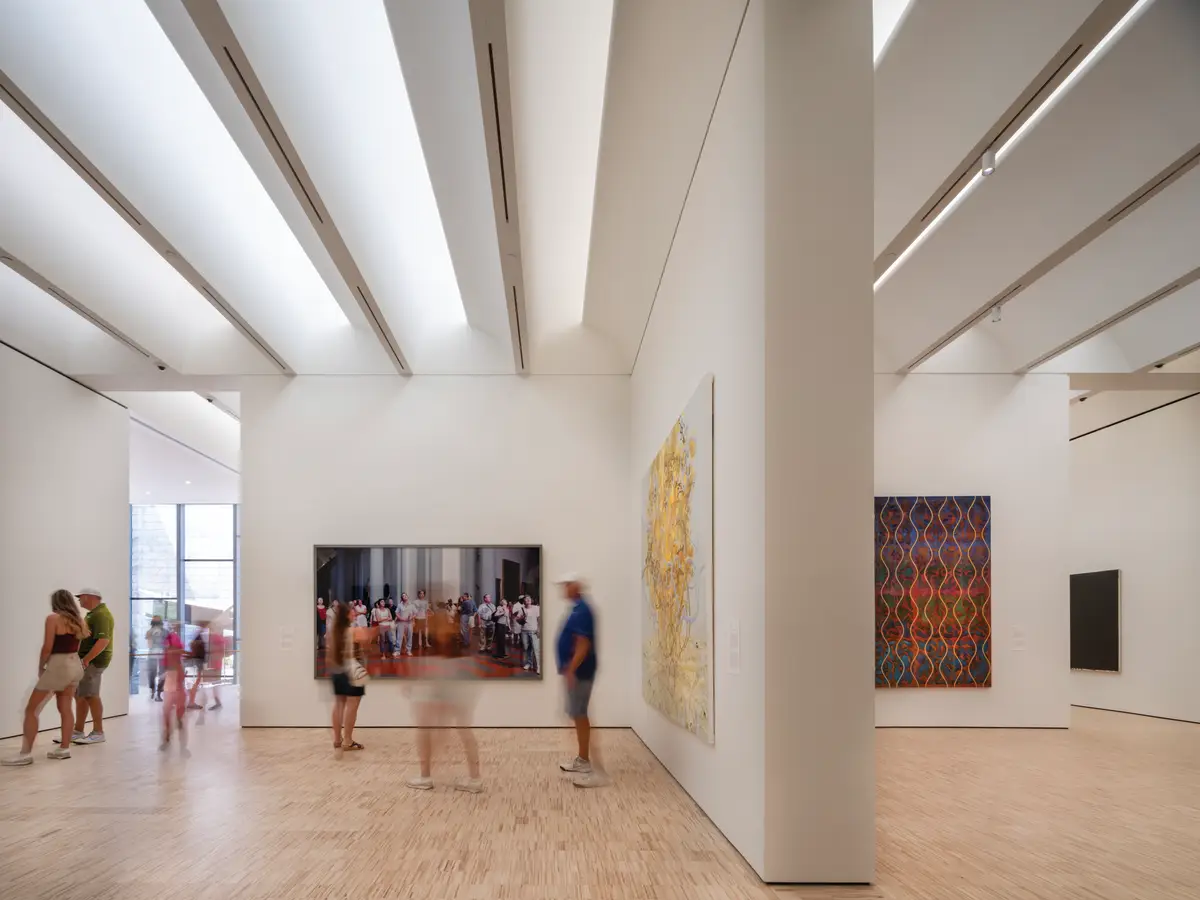
4
New and renovated exhibition space can be found in the Hawks Pavilion (4), the Memorial Building (5), and a sculpture-populated second-floor gallery overlooking the campus gardens (6). Photos © Nic Lehoux

5

6
“You’ve got a catwalk and technical lighting, in addition to big skylights, and lots of different shades that can mute the skylights or black them out as needed,” he says. “What you get below is something that’s a little more controlled than daylight, but also has that quality of color changing throughout the day. At other museums, you can usually see the skylights or the light source, and here we’re disguising both to create just a soft, glowing effect.”
Populating the light-filled Hawks Pavilion galleries is the first presentation of the 52-piece Phillip G. Schrager Collection of postwar and contemporary art. The collection, which comprises the most significant gift in the museum’s history, includes works by Roy Lichtenstein, Lynda Benglis, Gerhard Richter, Jenny Holzer, and Robert Irwin.
In tandem with the debut of the Hawks Pavilion, the Joslyn reopened with the first full reinstallation of its collections. The renovation of the Memorial Building—praised as one of America’s finest buildings upon its completion—includes new LED lighting, reconfigured garden-level administrative offices, two new educational spaces, a refurbished lecture hall, renovated meeting and classrooms, and myriad cosmetic fixes. Changes to the Joslyn’s grounds are even more marked. Once largely cloistered, the campus is now more welcoming to Omahans through the lowering of perimeter walls, one to the south and another to the east. Encompassing three acres, that effort, led by Snøhetta partner and landscape architect Michelle Delk, has yielded a new Great Lawn at the foot of the Memorial Building; a series of new and reimagined gardens serve as social spaces and open-air galleries for the museum’s growing sculpture collection. “There’s a unified composition that was in part inspired by some of the art that we saw in the galleries,” says Delk of the gardens, where the native grasses of the Great Plains and meadow plantings abound.
Ultimately, the new Joslyn Art Museum, with its trio of buildings woven together by a revitalized and accessible landscape, works so well largely because it avoids blotting out any of the site’s history. Says Dorf: “We created something new, the power of which actually lives in its ability to honor the old.”
Click drawings to enlarge
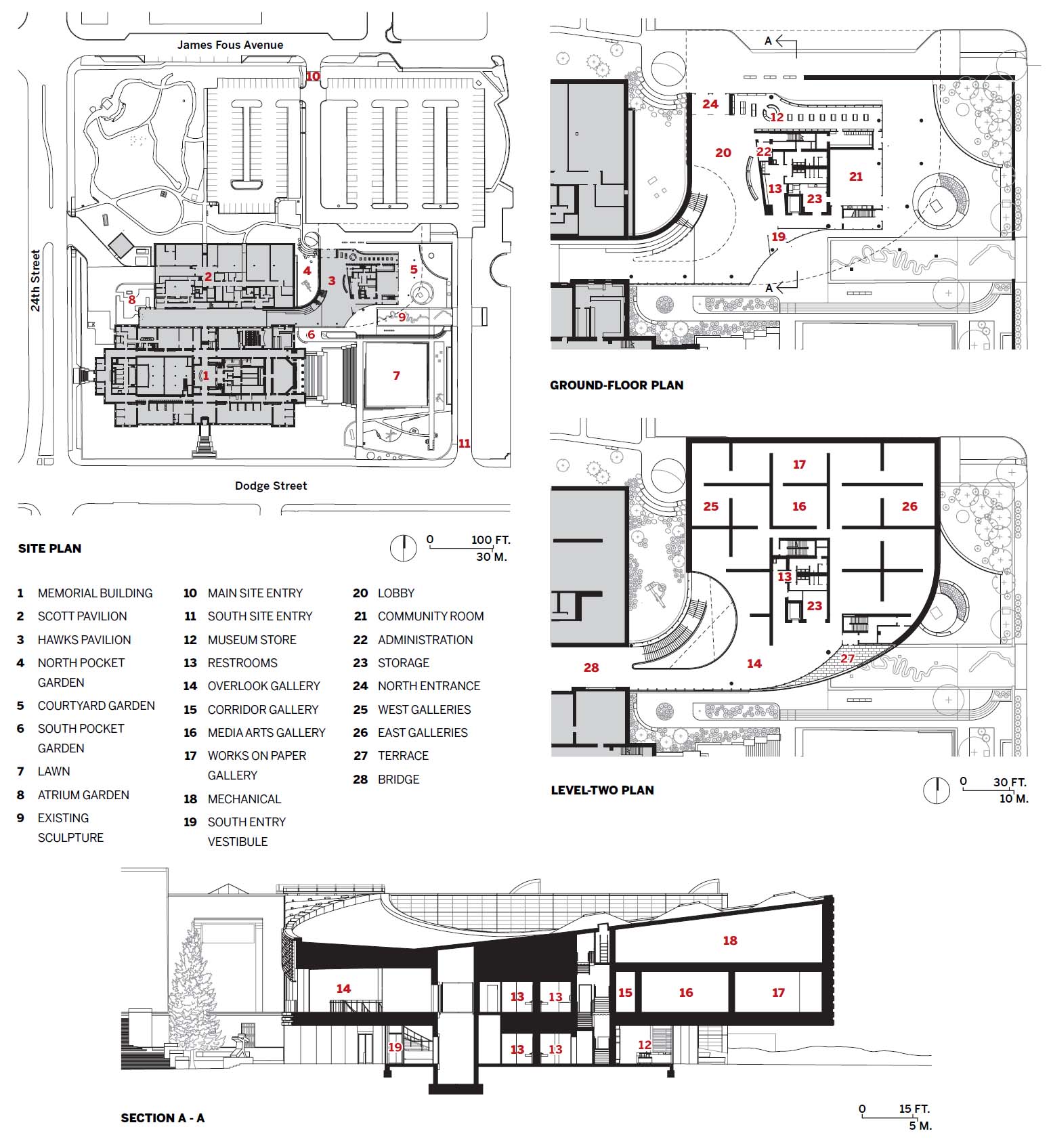
Credits
Architect:
Snøhetta — Craig Dykers, founding partner, architect; Michelle Delk, partner, landscape architect; Aaron Dorf, director, architect; Kate Larsen, director, landscape architect; Alex Stewart, senior project designer; Dan Marty, project architect; Laura Sandoval, Zeynep Göksel, Stephanie Loomis, project designers
Architect of Record:
Alley Poyner Macchietto Architecture
Engineers: MKA (structural); Thompson Dreessen & Dorner (structural engineer of record); Olsson Associates (civil); Morrissey Engineering (m/e/p/fp)
Consultants:
Anser Advisory (project manager); Front (facade); Arup (lighting, acoustics); A10 (sustainability)
General contractor:
Kiewit
Client:
Joslyn Art Museum
Size:
42,000 square feet (new construction); 20,800 square feet (renovation)
Completion Date:
September 2024
Sources
Exterior Cladding:
Coldspring (anchored stone masonry); Architectural Wall Systems/AWS, GATE Precast (rainscreen); Sto (exterior finish system)
Curtain Wall:
AWS
Glass:
AGC Interpane
Hardware:
Schlage (locksets); Sargent (closers)
Suspension Grid:
Armstrong
Acoustical Ceilings:
Pyrok
Paint:
Benjamin Moore
Plastic Laminate:
Formica
Carpets:
Interface
Flooring:
DeMarco Brothers (terrazzo), Kaswell Flooring (wood)
Solid Surfacing:
Caesarstone
Interior Shading System:
Draper, Veil Engineering
Lighting Controls:
Crestron
Plumbing:
Sloan (toilets), Toto (flush valves), Laufen (sinks)




